Soil sensing workshop reflections - pt.1
We had the pleasure recently of co-hosting an open lab with artists and researchers Nadia Campo Woytuk & Marie Louise Juul Søndergaard, who were visiting the Design+Change department to run a workshop and talk on their biomenstrual project.
Seeing some interesting possible points of overlap in elements of both of our projects we collectively took the chance of running an informal Open Lab together on the theme of soil sensing, fertility and fertilizers.
Nadia and Marie Louise's project investigates the creation of biodegradeable menstrual products that, as they told us in conversation, explore how intimate care can be a form of care for the environment. Their accompanying spell book for the project, Biomenstrual: A spell book for more-than-human menstrual care (https://files.persona.co/108249/Biomenstrual-spellbook.pdf), includes descriptions of how such a form of care could involve a cyclical process in which the blood and materials from such biodegradeable menstrual products could be used as composting nutrients for enriching the soil so as to be able to grow the plants and materials to make further such products. A promiscuous infusing of common and uncommon components - with a question being of where and whether to draw the normative line of such designations. As they told us at their own workshop carried out the day before, while the blood from slaughtered farm animals have long been used as a nitrogen rich form of blood meal for enriching soil nutrients, menstrual blood too has been used as fertilizer for many years across the globe, but these practices are rarely discussed scientifically in the same way as is the case for use of animal blood.
Prototypes, as propositions for alternative futures and practices, can mobilize promiscuous infusions of the common and uncommon, doing so (as in projects like Biomenstrual) with a view to challenging otherwise stablized norms and practices with enriching alternatives to such norms.
Over the course of a sunny day together, we planned and ran a simple workshop for trying out a variety of soil sensing techniques. Nadia had an NPK soil sensing kit for us to play around with and we had just recently been reading Leah Penniman's inspiring Farming While Black: Soul Fire Farm's Practical Guide to Liberation on the Land, in which they discuss indigenous soil methods used in Africa. The workshop also collided with the week of Easter, so we added in an additional Easter twist on proceedings.
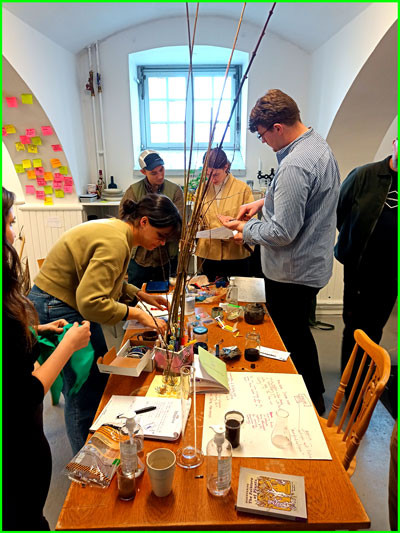
Rites of Spring
The workshop began with participants sharing stories of different Easter or Spring-related rituals and traditions relating to fertility, including examples from Poland, Transylvania, Denmark and Bosnia. Some of these rituals included gendered elements (the Easter Whip link: https://en.wikipedia.org/wiki/Easter_whip) and themes of rejuvenation, and in others, such as Eid al-Adha, themes of blood letting and sacrifice surfaced. At a local level, while visiting the farm to collect some willow branches before the start of the workshop, we were able to directly see the first furry yellow flowerings of pussy willow catkins at the tops of some of the willow branches that grow along the border of the farm. A natural indicator - what we could even call a sensor - of Spring in many Eastern European traditions, whereby "The pussy willow is the one that tells the rest of the world and all the other flora, trees and bushes it's time to wake up" (link: https://www.wbfo.org/local/2016-03-27/pussy-willows-are-a-symbol-of-easter). And indeed, the bees from the farm were already awake and at work on this early source of pollination (link: https://xerces.org/blog/plants-for-pollinators-pussy-willow).
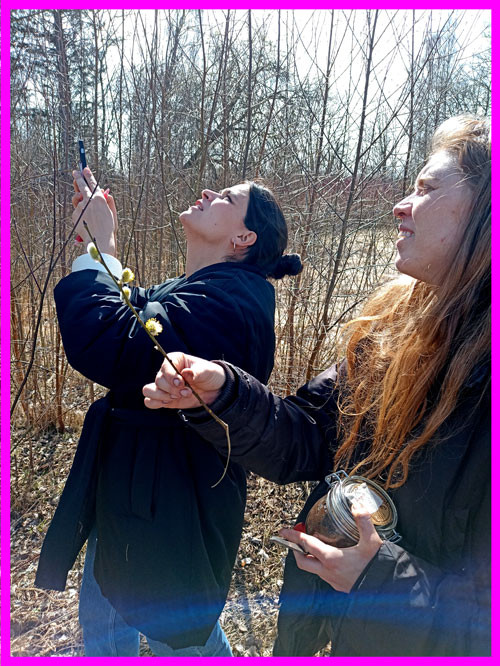
NPK testing
After our discussions, we broke out into clusters to try out two different common methods of soil sensing: NPK testkits and hand-based sensing. Those who sat down with the rainbow coloured NPK rapid test kits for measuring pH, Nitrogen, Phosphorous and Potash levels were quickly forced into what, in comparison to the hand-based sensing going on at the other end of the table, quickly took on a rather laborious sense of being made to faithfully follow instructions. As Jennifer Gabrys writes in their recent book How to Do Things with Sensors, citizen science approaches often involve such programmatic moments, a mode of learning that "requires settling into the instructional mode and the imperative mode" (Gabrys, 1). While the learning of such programmatic techniques can in some cases result in empowering possibilities for employing the technique in question in the world, in this case the immediate sense of a distance being created between the tester and the soil, as well as an inherent sense of this being an extractive mode of optimization put somewhat of a dampener on the procedure. The additional required wait for results only added to this sense of distance.
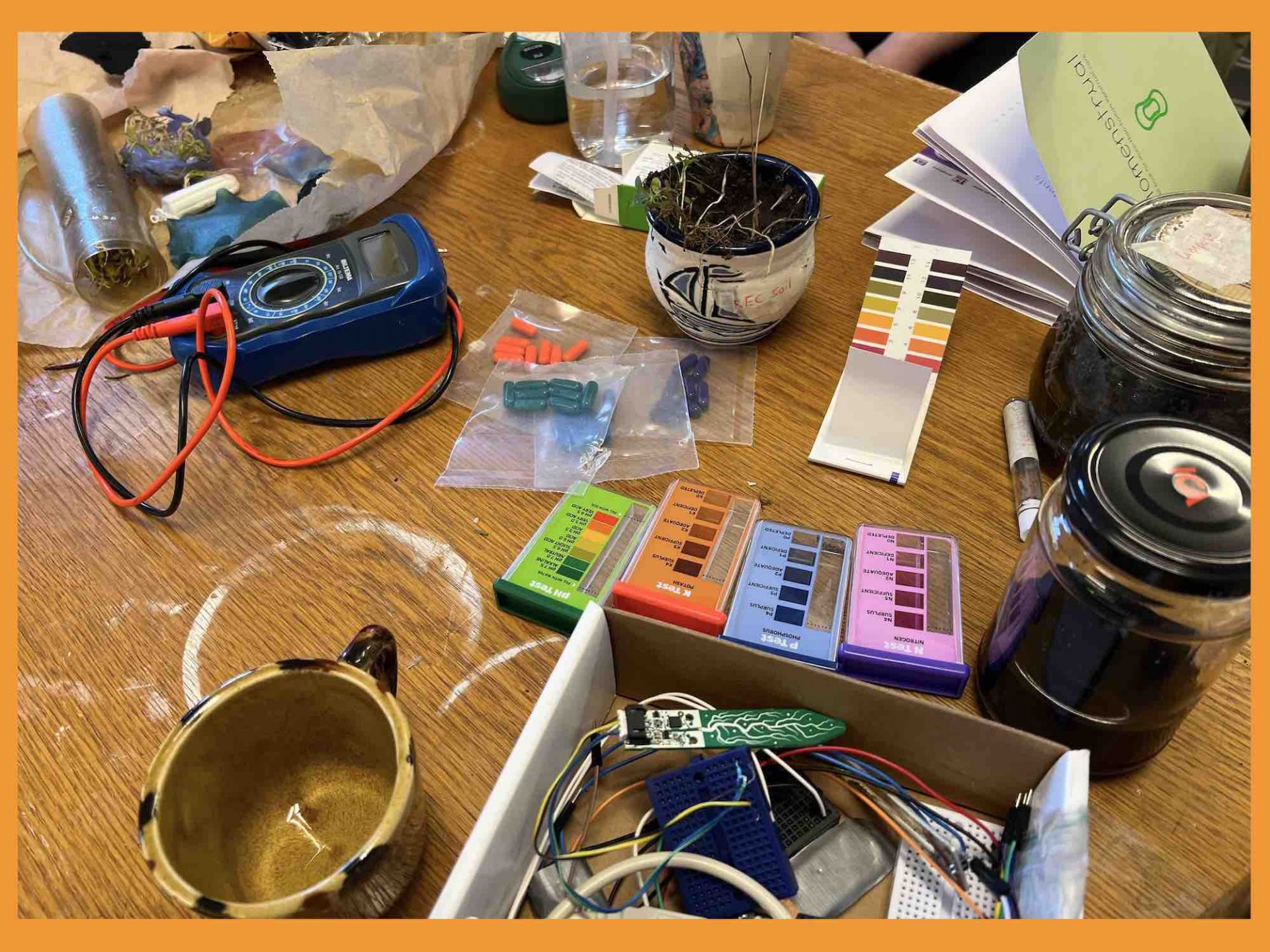
(image courtesy of Marie Louise Juul Søndergaard)
As Anton Poikolainen Rosén (thank you to Nadia for sending this text our way!) writes in a paper on different approaches to measure the temperature of heat composts made with horse manure, certain modalities of testing with kits and tools can unhelpfully "suggest an image of care as a methodical and instrumental practice of ‘handling’ bodies somewhat disconnected from emotion or intimacy" (Poikolainen Rosén), and there was clearly some sense of this with the NPK rapid tests. So for engaging others with soil in a way that builds regenerative ties and sensitivities to the living quality of soil, it is perhaps important to be weary of the dangers of instructional and imperative modes of engagement that readily establish such forms of distancing. As Gabrys suggest, it is important to always consider and explore, where relevant, "countervailing approach to instructions" (Gabrys, 3). Devising how-to modes of engagement that are both sensitive to the struggles of "surviving in a world with which one is at odds to how-to instructions", and in doing so, working to create empowering "strategies for making worlds that are more liveable" (3).
One nice alternative in this respect, one that Miranda improvised on the spot in the workshop, was exploring the ability of beetroots to act as a pH level sensor, one that responds with a very nice sense of colourful immediacy to inputs. It is one method we will explore some more, perahps trying approaches such as these on the farm (link: beetroot sensor: https://rosieresearch.com/natural-ph-indicator-cabbage-beets/).
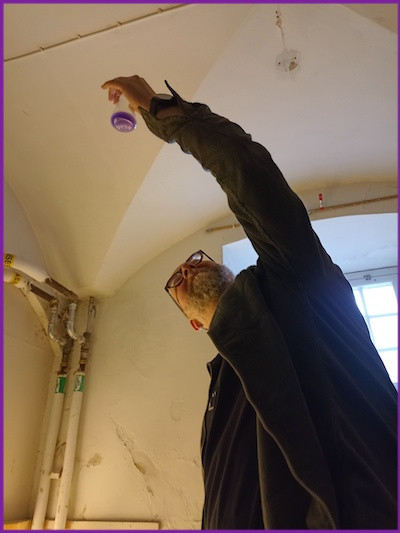
This has become a rather long post so pausing here and will continue in a bit with a followup post discussing the much more active soil sensing with touch, smell, and hearing, as well as colleague Zeenath Hasan's very helpful comments on companion forms of sensing. More in a bit!
references
Gabrys, Jennifer. 2019. How to Do Things with Sensors. University of Minnesota Press.
Poikolainen Rosén, Anton. “My thoughts were, in the earth” – How Leaving Civilization Behind is Leaving Patriarchy Behind
Penniman, Leah. 2018. Farming While Black: Soul Fire Farm's Practical Guide to Liberation on the Land. Chelsea Green Publishing.
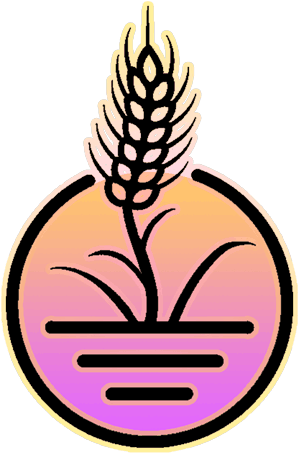
Leave a comment